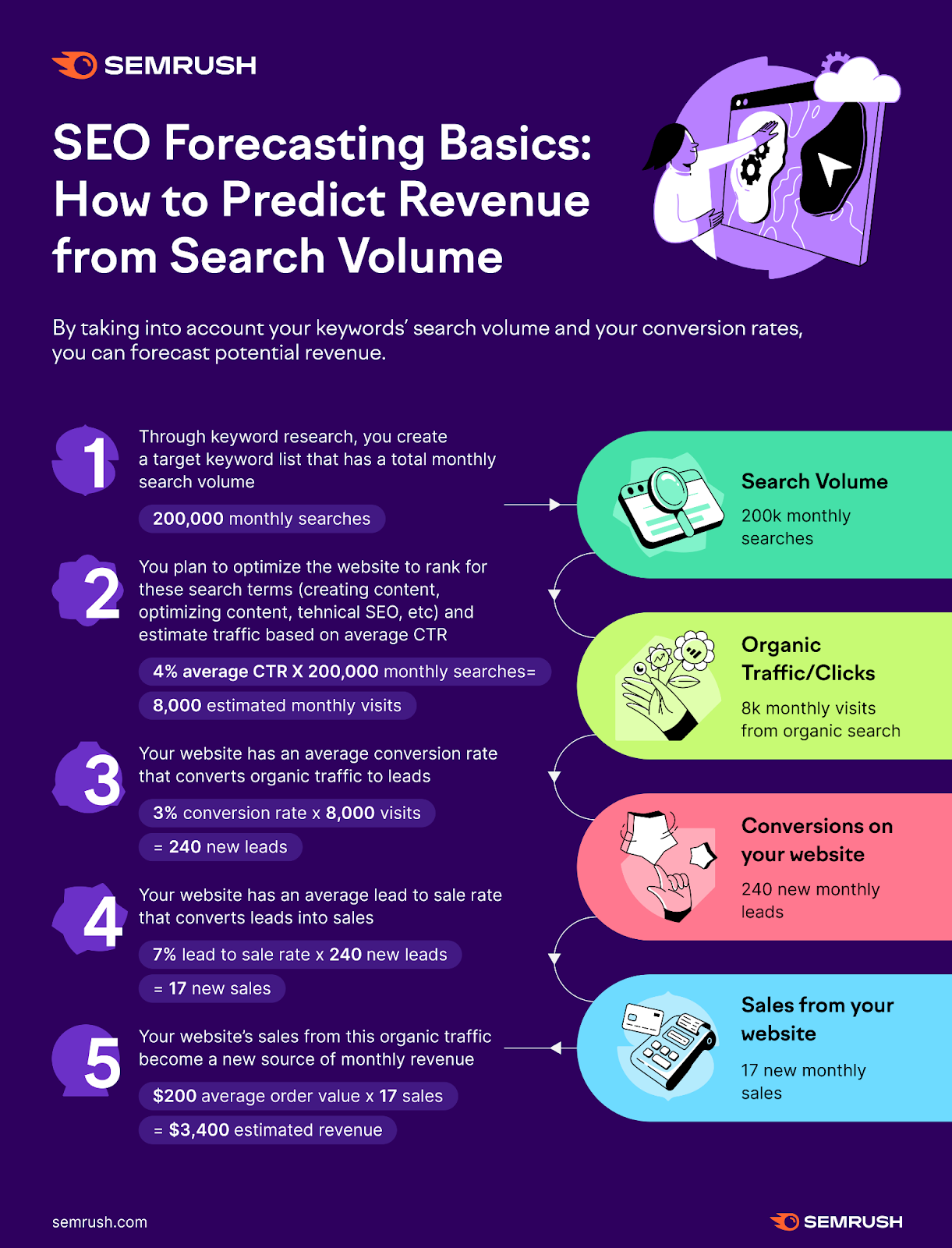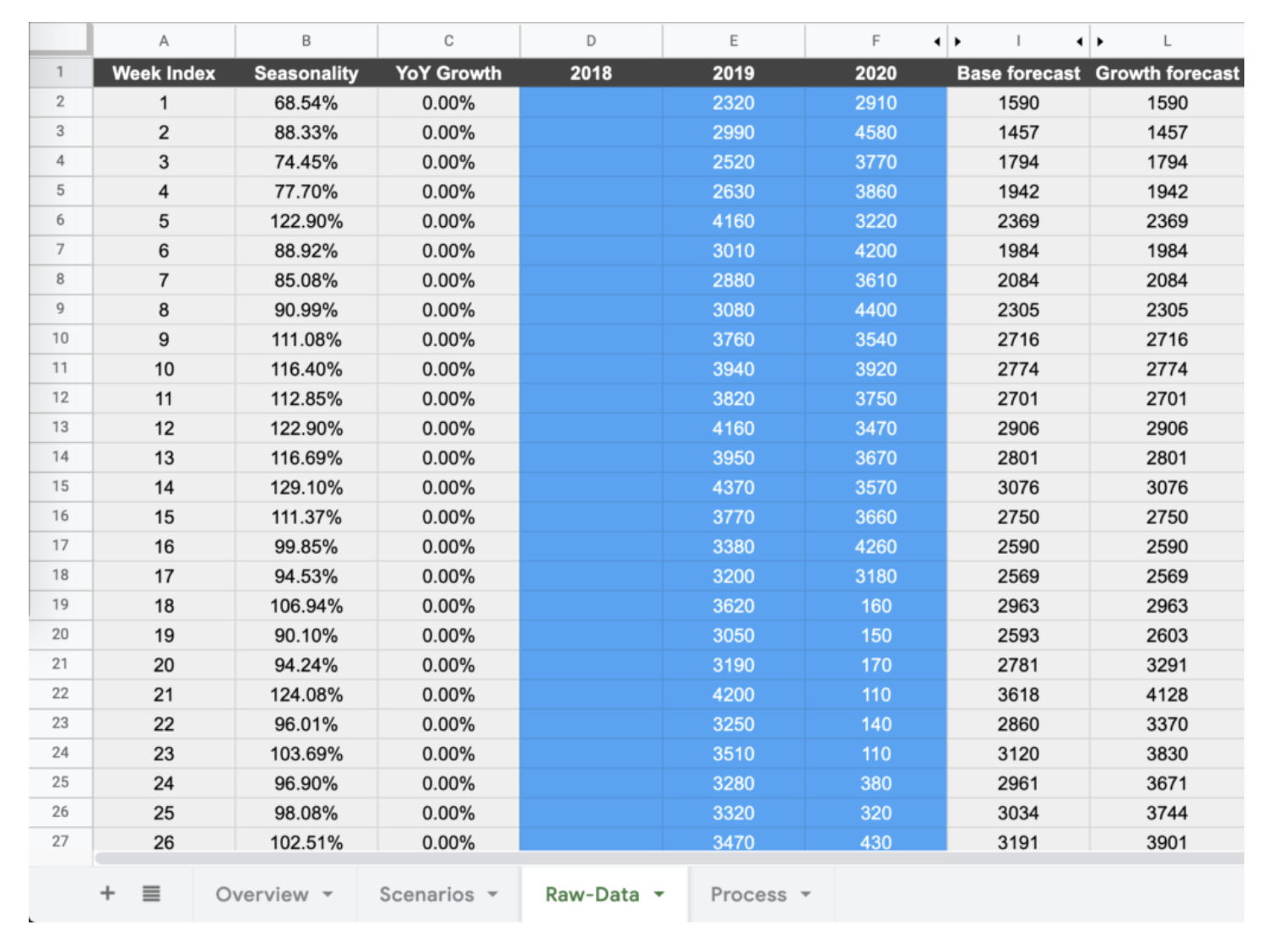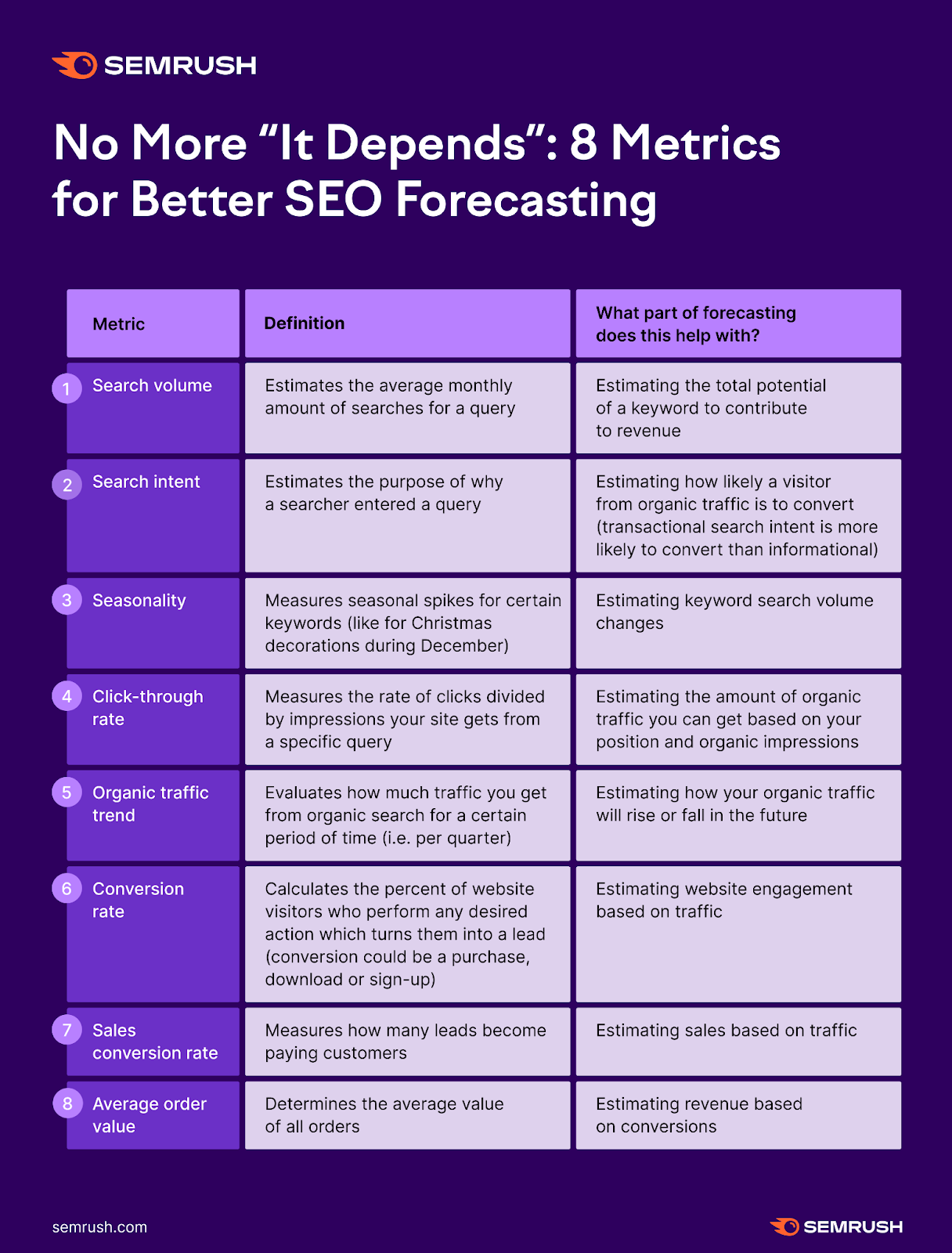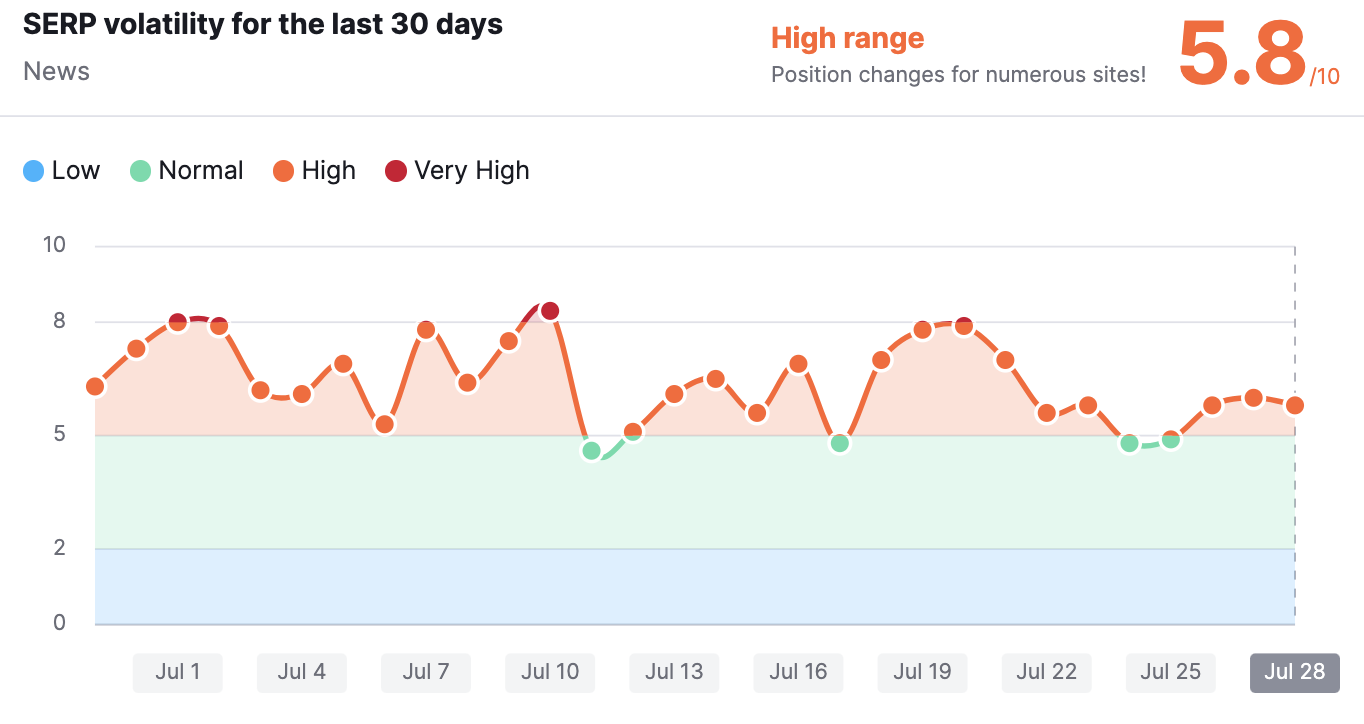Here’s a scenario SEO specialists know all too well: you find the perfect keywords, you create a blog post you’re sure Google will love, you post it, and it underperforms.
Surprise! And not a good one at that.
SEO forecasting can act as your method to avoid unpleasant surprises.
What Is SEO Forecasting?
SEO forecasting is when you predict future search traffic and value from SEO efforts.
It’s just one step in estimating revenue from SEO.
Other steps to take include calculating the cost of your investments, your site’s conversion rates, and ultimately, your sales. Think of it as a way to estimate revenue from organic traffic.
A quick Google search reveals that there isn’t one agreed-upon way to forecast SEO. It’s a complex task, and there are different opinions on how to get the most accurate results—which is why we asked several SEO pros for their viewpoints.
While an SEO forecast report is never exact, it can help businesses understand where to focus their efforts to get the most out of their strategies.

Why Is SEO Forecasting Important?
Estimating the impact of your SEO efforts can have great benefits:
- It gives you a competitive edge over other SEOs
- Proof for a bigger budget
- Better client relations
As SERPs change and SEO becomes more unpredictable, it’s more important than ever to have some form of setting expectations. You’ll appreciate it and so will stakeholders.
It Gives You a Competitive Edge Over Other SEOs
You have case studies, but so do your competitors.
So what sets you apart from them? Connecting the dots.
Many businesses have the idea that SEO is a good investment. Yet, they might not understand how clicks can translate into money.
Show how your plan can help a potential client stack against their keyword competitors in an ever-changing market and how that should translate in terms of their revenue. That can win you an account over another SEO or marketing agency.
Showing your client how you can improve their profits on a personal level is what will get you the contract over someone else.
It Gives You a Case for More Resources
Expectations are crucial in business. Especially in a world where we’re planning by months, quarters, even years.
SEO forecasting can establish an expectation so businesses can understand where to allocate resources to their digital marketing growth.
Here’s a hypothetical:
You work at a company where the social media department says they need to hire one more person for their team. Yet, your team could benefit from hiring a content writer to produce more content for the blog.
There’s only a certain amount of resources your company can dish out without busting its budget.
Who gets the new teammate?
The social media department helps get a solid amount of unpaid traffic to the company’s site, but so does your team through the blog’s content.
If you can prove how increasing content production on the blog could lead to more revenue, you’ll probably get more resources than a department that can’t.
SEO Forecasts Create Better Client Relations
Getting a vote of confidence from an employer or client isn’t easy. A survey by Backlinko’s Brian Dean shows that an alarming 70% of 1,200 small business owners wouldn’t recommend their current SEO specialist.
If you can prove that your actions should lead to a specific number of new visitors (and then customers), it’s easier for stakeholders to trust you.
It’s even easier for them to trust you if you can show how this all leads to the bigger picture: increased profits down the line.
Nik Ranger, Senior Technical SEO Specialist at DEJAN Marketing, sees the benefit:
Business case is everything—extremely compelling for a client to see input investment and potential outcome revenue.
Clients and employers trust SEOs who can show them why their plan will work. For one, it’s proof. But maybe most importantly, it’s transparent.
We surveyed 100 businesses in 2021. One of the biggest issues they had with marketing agencies was a lack of communication.
Creating an SEO forecast lets stakeholders in on the strategy, which improves communication and client relations.
Current Methods of SEO Forecasting
There isn’t a set way to an SEO forecast. Though, there are a few popular methods out there to get an SEO forecast that’s closest to the truth:
General Estimation
This is probably one of the simplest ways to forecast your SEO, so we’ll keep it brief. You look at how a website’s organic traffic performed in the past. You see it increased 10% YoY, or maybe it decreased (hopefully not).
You use this metric to estimate how much your organic traffic might increase in the future if you maintain the same amount of effort.
It doesn’t account for your competitor’s efforts or search engine algorithm trends in general. However, it still gives you an idea of how your SEO strategy could play out.
And it’s not a bad option, says Mordy Oberstein, Semrush Communication Advisor and Head of SEO Branding at Wix:
Since I’m not giving specifics and am just bucketing expectations, I usually have a sense of the general traffic potential of a topic—or conversely, the power of a page to rank for multiple KWs (think an FAQ page), so max, I’ll look at the Keyword Overview or Magic Tool to see search volume.
Excel Template to Forecast SEO
Spreadsheets are one of the most popular ways to forecast SEO. Software like Excel and Google Sheets has a number of built-in functions to make it easy to do complex calculations.
Of course, it’s a great candidate for quickly figuring out a company’s conversion rate and ROI.
Plug in the figures, apply a function/formula to the cell(s), and you have a nice overview of your key performance indicators in a neat package that’s easy to sort through.
You don’t have to figure it out alone. Kevin Indig made a template spreadsheet that calculates the result of your SEO efforts through historical data. It even considers factors that may affect your strategy, like a pandemic.

Or you can choose to pay for software like SEOarcade.
Want to customize your own? There are a few data points you might want to consider.
SEO Forecasting Metrics to Consider
When considering metrics for your forecast, it’s important to go deeper than just search volume.
Other metrics you may want to consider in your SEO forecast include:
- Click-through rate: clicks your site gets for a specific query divided by impressions
- Seasonality: measures seasonal spikes for certain keywords (like for Christmas decorations during December)
- Conversion rate: calculates the percent of website visitors who perform any desired action which turns them into a lead (conversion could be a purchase, download or sign-up)
- Organic traffic trend: evaluates how much traffic you get from organic search for a certain period of time (i.e. per quarter)
- Search intent: estimates the purpose of a user’s search
- Average order value (AOV): the average value of all orders
Which metrics you’d like to include depends on your business. You might find yourself choosing different ones along the way as you tweak your SEO forecast report.

Creating an Algorithm with Python
You can create an algorithm with the help of coding languages like Python to create predictive models.
Without getting too technical, Python has a set of built-in functions (much like a spreadsheet) that it pulls from its own library to make it easier to analyze data.
Though, unlike your average spreadsheet software, it can pull in massive amounts of historical data to make robust, data-driven estimates. Search Engine Journal has an in-depth post on how to use Python and the SARIMA model (Seasonal Autoregressive Integrated Moving Average) to measure SEO trends to predict how your strategy may perform in the future.
You can plug in data from your Google Analytics reports and third-party data (like Semrush) to get a personalized SEO forecast.
For those without a data science background, a model is a way to organize data in a way that shows their relationship. Also, hiring someone who knows their way around an integrated development environment (IDE) may be a good idea, like a web developer or data scientist.
Overcoming Uncertainties in SEO Forecasting
If only forecasting SEO was as predictable as forecasting the weather. Unfortunately, Google’s algorithm constantly changes.

This, paired with other unknown factors, makes it even harder to get on Google’s good side.
Conclusion
We never said that finding a process to predict the future of a site’s SEO was an easy job, but it’s worth the effort.
It’s because, in reality, it saves you more time and more money over time.
Nick LeRoy, Freelance SEO Consultant, sees it:
Forecasting is helpful when prioritizing a massive ‘to-do’ list. In a perfect world, we always want to prioritize efforts that require the lowest effort and highest ROI.
Instead of investing resources into campaigns that may not work, you can use SEO forecasting as a way to mitigate those risks. You can feel confident in your decisions because you have clear evidence of what the results should be.
Now, that’s not to say SEO forecasting is a perfect science.
You can estimate to some degree what your competitors will do and SERP volatility. You can’t know for a fact how the world of SEO will change.
Yet, it removes a degree of uncertainty that’s always present when you launch a campaign. Better planning often leads to better results. In turn, that leads to less money and time wasted.
Even if you’re not a Python pro, you can still use historical data from your website and third-party sources to forecast the results of your SEO strategy.
Written by SEMrush (Author: Alexis Frankel)
Link to Original Blog: https://www.semrush.com/blog/seo-forecasting/






